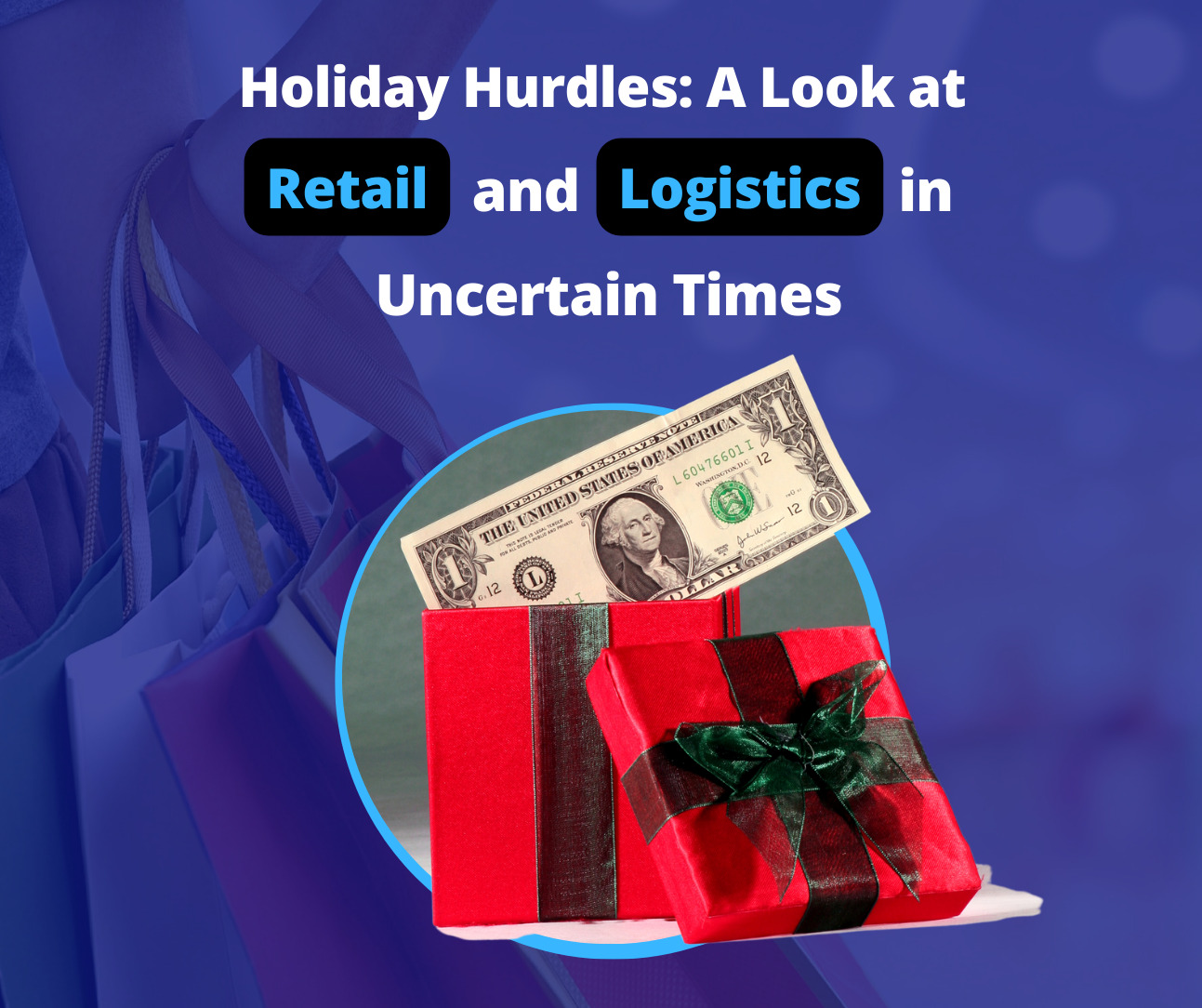
CNBC Supply Chain Survey
Implications for the Logistics Industry Amidst Economic Uncertainty
As the holiday season approaches, the state of freight and the broader logistics industry paints a picture of cautious optimism tinged with concerns. The CNBC Supply Chain Survey conducted between October 21 and 31 reveals a landscape where logistics companies brace for challenges amid an uncertain economic climate. The logistics sector is navigating turbulent waters, from reduced consumer spending to shipping disruptions and the looming threat of a trucking recession. This article explores key findings from the survey, providing insights into the current state of the logistics industry and the implications that reverberate through the supply chain.
1. Holiday Spending Outlook: A Cautionary Tale
Traditionally, the holiday season heralds a surge in consumer demand, propelling the logistics industry into a frenzied but lucrative period. However, insights from the CNBC Supply Chain Survey reveal a departure from the norm. Logistics companies are bracing for a holiday season characterized by cautious optimism this year. Several key points illuminate the subdued sentiment within the industry:
Cautious Customers and Retailers
Large Retailers’ Dilemma: Having diligently worked through excess inventories accumulated during the pandemic, major retailers are approaching the forthcoming season with caution. The emphasis is on avoiding the pitfall of over-ordering, a lesson learned from the challenges posed by the unpredictability of consumer behavior in recent times.
Destocking Among Small to Medium-Sized Retailers: In contrast, small- and medium-sized retailers are still navigating the destocking phase. The process involves deliberately reducing inventory levels, reflecting a conservative approach to align with market uncertainties.
Economic Inflection Point
Insights from C.H. Robinson: C.H. Robinson, serving a substantial clientele of 7,500 retailers, identifies a critical juncture in the U.S. economy. The concept of an inflection point implies an impending shift, and in this context, it pertains to consumer spending. Leading economic indicators—notably, loan and credit-card delinquencies—become signals of this potential transition.
Depleting Pandemic Savings: The analysis suggests that the U.S. economy is at a crossroads as Americans deplete savings accrued during the pandemic stimulus period. This depletion is evident in emerging trends, such as increased loan delinquencies, underscoring the nuanced challenges consumers face.
Pessimistic Outlook of Retailers and Shippers
FedEx CEO’s Assessment: Raj Subramaniam, CEO of FedEx, contributes to the narrative by expressing a cautious stance. While the period of destocking has concluded for retailers, the widespread restocking expected during a typical holiday season is notably absent. This observation adds a layer of pessimism to the overall outlook.
Persistent Concerns: The survey captures prevailing concerns among retailers and shippers regarding weak consumer spending. The cautiousness extends beyond the destocking phase, indicating a prolonged period of economic uncertainty that influences decision-making within the supply chain.
Quantifying the Subdued Sentiment
It is crucial to explore relevant statistics and contextualize the impact to grasp the depth of this subdued sentiment within the logistics industry:
Inventory-to-Sales Ratio: The caution exercised by large retailers is reflected in the national inventory-to-sales ratio. While on the surface, it might appear to have returned to pre-pandemic levels, the data is skewed. This skewness is attributed to the cautious approach of major retailers, emphasizing quality over quantity in their inventory management practices.
Size Disparities in Retailer Strategies: The stark difference between the strategies of large and smaller retailers is evident. Having weathered the storm of excess inventories, large retailers now focus on precision and prudence. In contrast, smaller players are still grappling with destocking, highlighting the varied impact on businesses of different sizes.
Consumer Spending Indicators: The nuanced economic inflection point is substantiated by indicators such as loan and credit-card delinquencies. The data serves as a tangible representation of the challenges consumers face, contributing to the overall caution observed in the logistics landscape.
2. Logistical Strategies Amid Economic Uncertainty
The cautious economic climate prompts retailers and logistics companies to reassess their strategies. This section explores the strategies and challenges faced by the logistics sector:
Promotional and Lower-Cost Items: Most logistics firms (67%) indicate that products moved into stores this holiday season are more promotional and lower-cost. A substantial 83% reveal that they are not selling more high-priced items.
Supply Chain Savings: Grappling with higher costs, retailers are limiting discounts on popular items. Logistics companies collaborate with them to find savings elsewhere in the supply chain. Purchase orders that can be held and consolidated in a retailer’s transportation schedule become sought after, potentially saving shippers 10-15%.
Uncertainty Surrounding Lunar New Year: Orders surrounding the Lunar New Year, a crucial time marked by manufacturing plant closures in China, present a muted outlook. A majority (67%) do not anticipate an order increase. Products experiencing the most significant pullback include household goods, luxury items, and aspirational luxury items.
3. Freight Volumes: Navigating Peaks and Valleys
The survey sheds light on expectations regarding freight volumes, presenting a mixed outlook for the near future:
First Half of 2024: 34% of respondents expect freight volumes to be down either 5% or 10%, while an equal percentage anticipates an increase of 5%. The remainder expects volumes to remain unchanged.
Second Half of 2024: Expectations for a turnaround emerge in the second half of 2024. Half of respondents expect a 5% increase, 33% anticipate a 10% increase, and 17% are the most optimistic, foreseeing a 15% increase.
Global Economic Uncertainty: The overall uncertainty climate defines the market. Logistics companies make different bets with their inventory strategies, reflecting the unpredictable nature of the global economy.
4. Shipping Dynamics: Negotiation Season and Rate Expectations
In addition to the quantity of freight moved, logistics companies on water, road, and air generate revenue based on the rates they can charge. This section provides insights into rate expectations and negotiations:
Ocean Freight Prices: Most respondents believe ocean freight prices for the first and second quarters will be unchanged or down. The reduction in daily vessel crossings in the Panama Canal has influenced the trade flow, with 60% of respondents noting increased freight movement to the U.S. West Coast.
Air Freight Rates: The majority anticipates rates to be unchanged or down anywhere from 10% to 20% for air freight. Global shipping bellwether Maersk’s announcement of 10,000 layoffs amid weak results underscores the challenges in the industry.
Trucking Recession: The freight trucking sector, crucial for the timely movement of goods, faces challenges. Dependent on load volume, trucking companies anticipate potentially lower revenue this holiday season. The sector has witnessed numerous bankruptcies and closures, contributing to what’s described as a “massive freight recession.”
Wrapping Up
The logistics industry finds itself at a critical juncture, navigating challenges posed by economic uncertainty, shifting consumer behavior, and disruptions in shipping dynamics. As we head into the holiday season and beyond, stakeholders in the logistics and shipping industries must remain agile, responsive, and collaborative. Adapting strategies, leveraging cost-saving measures, and navigating freight volumes’ peaks and valleys will be instrumental in determining success in this dynamic landscape. The coming months will unfold as a test of resilience for the logistics sector, where strategic decisions made today will shape the industry’s trajectory in the months and years to come.


